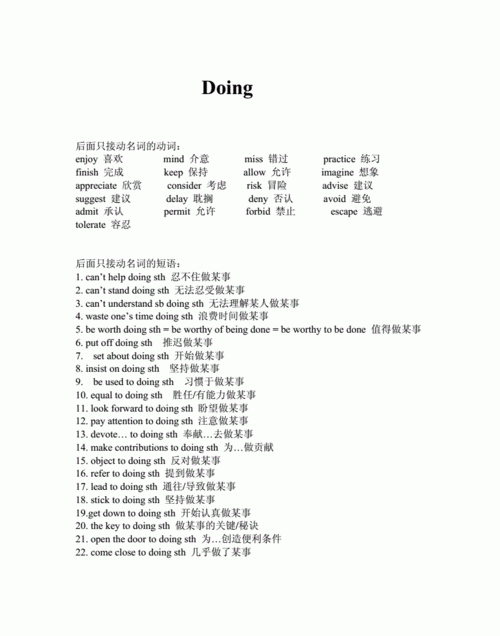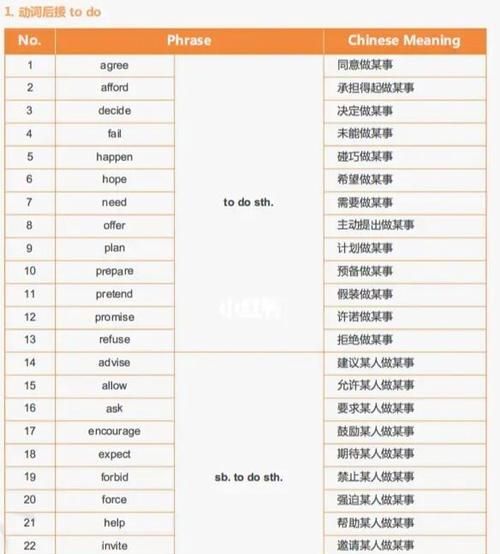本文目录
后面接to doing的短语
1 跟动名词(doing)和动词不定式(to do)均可的词,含义无区别:
start,begin,continue,prefer,like,love,hate,后跟to do 表具体和特定的动作后跟 doing 表泛指的动作
2 跟动名词(doing)动词不定式(to do)均可的词,含义区别较大:
1.stop to do---stop doing mean doing
2.mean to do---mean doing
3.try to do---try doing
4.agree to do---agree to sb doing
5.be afraid to do---be afraid of doing
6.remember to do---remember doing
7.forget to do---forget doing
8.allow/permit/advise sb.to do---allow/permit/advise doing
9.regret to do---regret doing
10.want to do---want doing (表被动)
11.need to do---need doing(表被动)
12.go on to do---go on doing
13.can’t help to do---can’t help doing
14.forbid sb.to do=forbid sb’s doing---forbid doing

什么短语的后面是to doing 一般只有to do 我记得有个是look forward tp doing
remember doing sth.记住曾做过某事
2.forget doing sth.忘记曾做过某事
3.try doing sth.做某事试试看有何效果
4.mean doing sth.意味着做某事
5.can't help doing sth.禁不住做某事
6.go on doing sth.继续做一直在做的事
注:stop to do sth.与stop doing sth.也不同,前者指停下来去做某事,后者指停止正在做的事,但stop to do sth.中的不定式不是宾语,是目的状语。
只+doing做宾语的动词有:
finish, enjoy, suggest, mind, dislike, practice, miss, keep, advise, allow, forgive, imagine, prevent, understand, resist, reject, consider, avoid, delay, deny, excuse, admit, endure, escape, pardon, postpone, risk, fancy, tolerate等。还有get/be used to(习惯于), can’t help/ can’t stand(禁不住), feel like, look forward to, pay attention to, give up, be worth, be busy, be fond of(喜欢), object to, lead to, put off, insist on/stick to(坚持), keep on, keen on(渴望), refer to(参考)等短语之后(因为要做介词宾语),以及sb spend sm/st (in), have difficulty/trouble (in), have fun/pleasure (in), it’s no use/good, it’s ( a) waste of time (in), there is no (不可能e.g.: There is no joking about such matters. 译文:这种事开不得玩笑。)等句型后。
不定式to do和动名词doing作宾语的区别
英语中大多数动词既可跟不定式,也可跟动名词作直接宾语,但有些动词要求:
(1)不定式做宾语和宾语补足语
1)下面的动词要求不定式做宾语
attempt企图 enable能够 neglect忽视
afford负担得起 demand要求 long渴望
arrange安排 destine注定 mean意欲,打算
begin开始 expect期望 omit忽略,漏
appear似乎,显得 determine决定 manage设法
cease停止 hate憎恨,厌恶 pretend假装
ask问 dread害怕 need需要
agree同意 desire愿望 love爱
swear宣誓 volunteer志愿 wish希望
bear承受 endeavor努力 offer提供
beg请求 fail不能 plan计划
bother扰乱;烦恼 forget忘记 prefer喜欢,宁愿
care关心,喜欢 happen碰巧 prepare准备
decide决定 learn学习 regret抱歉,遗憾
choose选择 hesitate犹豫 profess表明
claim要求 hope希望 promise承诺,允许
start开始 undertake承接 want想要
consent同意,赞同 intend想要 refuse拒绝
decide决定 learn学习 vow起
contrive设法,图谋 incline有…倾向 propose提议
seek找,寻觅 try试图
2)下面的动词要求不定式做宾补:动词+宾语+动词不定式
ask要求,邀请 get请,得到 prompt促使
allow允许 forbid禁止 prefer喜欢,宁愿
announce宣布 force强迫 press迫使
bride 收买 inspire鼓舞 request请求
assist协助 hate憎恶 pronounce断定,表示
advise劝告 exhort告诫,勉励 pray请求
authorize授权,委托 help帮助 recommend劝告,推荐
bear容忍 implore恳求 remind提醒
beg请求 induce引诱 report报告
compel强迫 invite吸引,邀请, summon传唤
command命令 intend想要,企图 show 显示
drive驱赶 mean意欲,打算 train训练
cause引起 instruct指示 require要求
deserve应受 leave使,让 tell告诉
direct指导 like喜欢 tempt劝诱
entitle有资格 order命令 warn告诫
enable使能够 need需要 urge激励,力说
encourage鼓励 oblige不得不 want想要
condemn指责,谴责 lead引起,使得 teach教
entreat恳求 permit允许 wish希望
(2)有少数动词只能用动名词作宾语
acknowledge承认,自认 cease 停止 mention说到,讲到
admit 承认 tolerate忍受 dislike不喜欢,讨厌
advocate:提倡,主张 complete完成 dread可怕
appreciate 感激,欣赏 confess坦白 endure忍受
avoid避免 contemplate细想 enjoy享有,喜爱
bear忍受 defer拖延 envy嫉妒
can't help不禁 delay延迟 escape逃跑,逃避
can't stand受不了 deny否认 excuse借口
consider 考虑 detest嫌恶 fancy幻想,爱好
favor 造成,偏爱 mind 介意 repent悔悟
figure描绘,计算 miss错过 resent怨恨
finish完成,结束不得 pardon原谅,饶恕 resist抵抗,阻止
forgive原谅 permit 允许 resume恢复
imagine设想 postpone延迟,延期 risk冒险
involve卷入,包含 practise 实行,实践 suggest建议
hate讨厌 prevent阻止 save营救,储蓄
keep保持 quit放弃停止 stand坚持,忍受
loathe非常讨厌,厌恶 recall回想
例如:I appreciate having been given the opportunity to study abroad two years ago.我很感激两年前给我出国学习的机会。
(3)有些动词后使用动名词和动词不定式作宾语的差别
1)forget to do 忘记要去做某事(此事未做)
forget doing忘记做过某事(此事已做过或已发生)
2)stop to do 停止、中断(某件事),目的是去做另一件事
stop doing 停止正在或经常做的事
3)remember to do 记住去做某事(未做)
remember doing记得做过某事(已做)
4) regret to do对要做的事遗憾
regret doing对做过的事遗憾、后悔
5)try to do努力、企图做某事
try doing试验、试一试某种办法
6) mean to do打算,有意要…
mean doing意味着
7)go on to do 继而(去做另外一件事情)
go on doing 继续(原先没有做完的事情)
8)propose to do 打算(要做某事)
proposing doing建议(做某事)
9) like /love/hate/ prefer +to do 表示具体行为;+doing sth 表示抽象、倾向概念
(注)如果这些动词前有should一词,其后宾语只跟不定式,不能跟动名词。例如:
I should like to see him tomorrow.
10) need, want, deserve +动名词表被动意义;+不定式被动态表示“要(修、清理等)”意思。
Don't you remember seeing the man before?你不记得以前见过那个人吗?
You must remember to leave tomorrow.你可要记着是明天动身。
I don't regret telling her what I thought.我不后悔给她讲过我的想法。(已讲过)
I regret to have to do this, but I have no choice.我很遗憾必须这样去做,我实在没办法。(未做但要做)
You must try to be more careful.你可要多加小心。
Let's try doing the work some other way.让我们试一试用另外一种办法来做这工作。
I didn't mean to hurt your feeling.我没想要伤害你的感情。
This illness will mean (your) going to hospital.得了这种病(你)就要进医院。
这个挺详细的

todoing的短语搭配
want sb to do sth
make sb do sth
mind doing sth
finish to do sth
finish doing sth
like to do sth
like doing sth
listen to sth
hear sb to do sth
forget to do sth
forget doing sth
how to do sth
used to do sth
by dong sth
wait sb to do sth
hope to do sth
sb want to do sth
be busy doing sth
do one's best todo sth
sb need to do sth
try to do sth
tell sb to do sth
tell sb not to do sth
stop sb from doing sth
have trouble doing sth
lend sb to do sth
manage to do sth
go on doing sth
be interested in doing sth
be afraid to do sth
too...to do sth
end up doing sth
get used to do sth
What about doing sth
would like to do sth
mind one's doing sth
be make up of doing sth
get to do sth
become expect at doing sth
succeed in doing sth
ask sb about doing sth
arrived in doing sth
love to do sth
love doing sth
it is time to do sth
enjoy doing sth
do well in doing sth
the best way to do sth
you'd better to do sth
practice doing sth
watch sb to do sth
decide to do sth
give up doing sth
agree to do sth
see sb doing sth
allowed sb to do sth
invite sb to do sth
make a conctribution to doing sth
prevent from doing sth
remember to do sth
remember not to do sth
remember doing sth
drop doing sth
drop to do sth
consider doing sth
pretend to do sth
prefer to do sth
can't stand doing sth
be shocked by doing sth

后面加todo和doing的单词
1.动词+介词to+动名词
(1) admit to doing sth. 承认做了某事
He admitted to breaking the window.
(2) apply to doing sth. 适用于做某事
The technology is applied to creating more products.
(3) object to doing sth. 反对做某事
He is object to doing that.
(4) see to doing sth. 负责做某事
I'm seeing to taking care of the olds here.
(5) stick to doing sth. 坚持做某事
Don't give up! Stick to hard working and you'll soon succeed.
(6) take to doing sth. 喜欢上做某事,逐渐习惯做某事
He takes to going to school on foot.

以上就是关于那些短语后面接todoing,后面接to doing的短语的全部内容,以及那些短语后面接todoing 的相关内容,希望能够帮到您。

